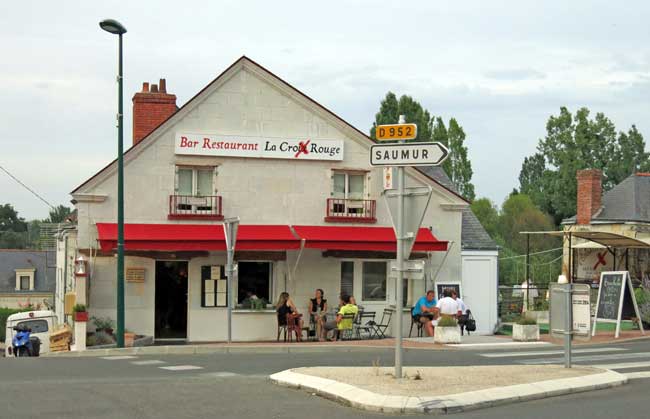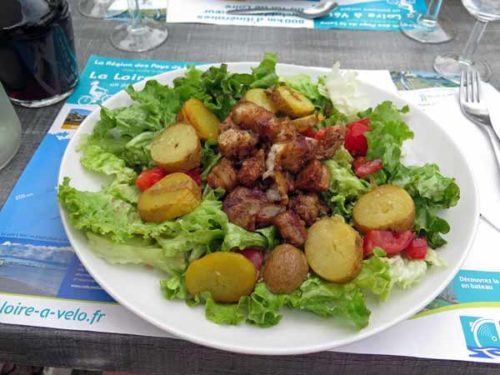Friday, 18 July 2014
Distance 21 km
Duration 4 hours 30 minutes
Ascent 10 m, descent 18 m
Maps 125 and 139 of the TOP100 lime-green series

As we were packing up in the morning, I could not find the maps that we needed for today – the irreplaceable, detailed maps that we had made ourselves. As a last resort I went to the shower block where I had cleaned my teeth the night before, and there they were, untouched. That is the benefit of getting up before the cleaners arrive.
Years earlier we had walked from Montsoreau to Saumur and it had not been an edifying experience. With only the TOP100 map to guide us, the choice had been between the GR3, an unsatisfactory jumble of deviations up and down the escarpment, and the highway (the D947), which was horrid but only half the distance. We had gone for the latter because the weather was scorching and we wanted to arrive as quickly as possible.
This time we had done a bit of research beforehand, using the Géoportail website, and discovered that there were tracks in the forested strip between the highway and the river, which would allow us to get most of the way to Saumur without stepping on bitumen.

We set off at 6:50 am past the squalid cyclists’ ghetto, where all the occupants seemed to be still asleep, and followed a bike track through the woods, then under the road bridge and on for a few kilometres until it turned up towards the highway.
Here we parted company with it and continued on a thin path which wound its way through the trees, eventually emerging onto the grassy bank of the Loire.
After a while we came to an open area where the Loire split into two strands around the Île de Souzay, and we intended to stay close to the left bank, but somehow amidst all the tracks, we found ourselves heading up to meet the highway, just past Parnay.

Having got that far, we stayed on the highway as far as Dampierre-sur-Loire in the hope that the bar of our previous walk would still be functioning, but it was gone.
The main point of interest on this short road-bash was the sign informing us that we were crossing the Greenwich meridian.

This underlined what we already knew – that all this side of France was wildly asymmetrical in the times of sunrise and sunset, especially in summer, when the sun rose at 6 am and set at 10 pm.

We turned off again after Dampierre and found a delightful path that hugged the river bank for a while, then wandered through a sandy grove.
Surprisingly quickly we saw the railway bridge spanning the river ahead and our path came to an end at the highway.
It was still a fair way to the centre of Saumur, and as the highway was now right on the edge of the water, we had no choice but to trudge along it, beside the walled embankment.

We passed the russet dome of Notre Dame des Ardilliers, standing like a huge, lichen-encrusted boulder beside the road, then the spiky turrets of the château further back on the ridge, and arrived at the centre of Saumur.
There was a solid line of shops and bars along this strip, but they were all in the sun at this hour (just after 9 am), so we decided to push on over the river before stopping for refreshments.
The bridge of Saumur consists of two parts separated by the long island where we had camped on our previous visit.

The second part of the bridge commemorates the Cadets of Saumur, the young soldiers who had tried to defend the town from the invading Germans in June 1940, with terrible losses.
We bought four pastries as we passed a boulangerie, to avoid having to hunt for them later, and they got rather squashed in the top of my pack before we sat down at the bar opposite the station. Nevertheless we enjoyed them greatly – two apple chaussons, a croissant and a pain aux raisins.

We sat outside on the pavement, and after we had drunk our coffee, Keith went in and found the local paper on the counter. We had not seen a paper, nor heard any news, for several days.
The front page was wholly taken up by the terrible story of the Malaysia Airlines plane shot down over Ukraine a day or two before.

This was bad for our digestion, as we were booked to fly on the same airline in three days’ time, and we remembered that we had gone directly over Ukraine on our flight from Australia. But there was nothing to be done, so we tried to put it out of our minds.
Setting off from this break, which had not been as restful as we expected, we followed the railway line for a while, then went under a road bridge and passed a fine old church, white and grey like all the other buildings in this area. Soon after that we went over a level crossing and left the town behind.

The country was as flat as a lake to the horizon, but the little road that we were on (Rue de Boumois) was raised, and we realised that we were on the levee bank which held back the waters of the Loire during floods.
Below us was an endless quilt of orchards, vegetable farms and wheat fields, with villages clustered here and there. We had planned to take a zig-zag route amongst these fields, but when we saw how minor the Rue de Boumois was, we decided to stay on it and enjoy the view. All the traffic was on the highway (the D952), between us and the river.

After about an hour we reached the gates of the Château de Boumois, and the road turned under a railway bridge and met the highway, which had now taken possession of the levee bank.
It was a very busy road, but we did not need to walk along it because there was a grassy track on the low ground on the other side, and that took us the short distance to the camping ground turn-off.
We were not quite at the village of St-Martin-de-la-Place, but at the place called la Croix Rouge. At this intersection we were delighted to see a restaurant, and the barman assured us it would be open in the evening.

The camping ground (Terre d’Entente) was down on the edge of the Loire, a beautiful smooth lawn shaded by deciduous trees in their summer glory, with caravans and tents spread about.
Madame in the office told us that we could camp anywhere, and we chose a spot next to the fence that separated the camping ground from a public path along the river bank. From here we could look across the water to the southern shore, where we had walked in 2006.
The shower block was high up on stilts, reached by a long flight of steps, and we wondered why for a moment, until we remembered that we were now on the river side of the levee bank and presumably susceptible to floods.

After ablutions and lunch, we lazed about in the shade, moving regularly to avoid the encroaching sun. There were people bathing at a little beach below us, while cyclists and people with dogs went past on the path.
A man from the campsite next to us came over to ask politely who we were. He was Dutch, and naturally spoke perfect English. He and his wife had been puzzling about our lack of a vehicle, or even a bike, and had come to the conclusion that we had arrived by bus. At the news that we had walked he could hardly believe his ears, although he then admitted that his wife had dreams of walking from Holland to Compostela – dreams that she would never act on, he added.
He invited us to come for a drink, but as we were on the point of setting off on an exploratory stroll around the village, followed by dinner, we said that we would call in afterwards. The gate leading to the path was locked but as campers we had the code, so we went out and meandered through a pleasant park beside the river until we got to a sort of boat-ramp. From here we walked up and crossed the highway into the centre of St-Martin-de-la-Place.
It was a pretty little place, but deathly quiet and seemingly devoid of anywhere to dine. There was an imposing Logis hotel but no indication that it had a restaurant. Luckily we did not need one, nor did we need a bar for our apéritifs, as we had noticed an outdoor eatery down near the river, just past the boat ramp.

This ramshackle establishment was called le Bato and had tables and chairs set up on duckboards on the sand, with loud pink umbrellas lashed to posts, and the brimming Loire a few steps away.
It had a rakish charm and we ordered glasses of the delicious local rosé to prepare ourselves for dinner at la Croix Rouge.

As a short cut we walked back to the restaurant along the side of the busy road. A night market had set itself up opposite and it was a lively scene, with people moving about among the vans.
The clear sky of earlier in the day had given way to heavy clouds but it was still warm, so we ate in a sort of sunken courtyard attached to the restaurant.
The only other occupants were two English couples and a group of local girls, dressed to kill, who were having drinks before moving on to somewhere more glamorous.
We had one €20 menu, plus an extra main dish, which meant that we shared the first course and Keith ate the dessert.

We began with a salade angevine (the name referring to the fact that we were now in the old province of Anjou, centred on Angers). This was a large, nourishing assemblage of lettuce, tomatoes, potatoes and fried pork. When he realised that we were sharing, the chef, whose name was Xavier, passed an extra plate out through the open window for Valérie, the waitress, to give us.
After that we both had steaks, specifically bavettes, accompanied by what amounted to another salade angevine.

We were just setting to work on this when it started to rain and we rushed inside, carrying our plates, glasses, bread basket and wine carafe.
The interior of the restaurant was a pleasant haven for the rest of the meal, which turned out to include a cheese course as well as dessert.

We put the cheese away for another day and Keith polished off a crème brûlée in the interests of science. His doctoral studies on regional variation in this dish had been sorely neglected in the last few days.
By the time we finished, the rain had passed so we strolled down to the camping ground, scaled the heights to the ablutions block to clean our teeth, and then presented ourselves at the caravan of our Dutch neighbours, who were sitting on deck chairs with another Dutch couple, admiring the sunset over the river.

They offered us mugs of tea, a great novelty, not to mention conversation in English. We realised how starved we were for normal sociable talk.
Both couples had been at this camping ground for weeks, and told us that a beaver, apparently a native of the area, swam up the river every day.
The sun was dissolving into the calm waters of the Loire as we said good night to these fine people, and crawled into our little home.
During the night there were huge storms, with much crashing and flashing, and torrents of rain, but we stayed dry.
Previous section: Châtellerault to Montsoreau